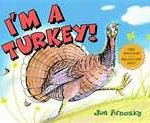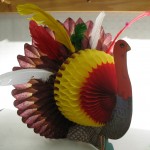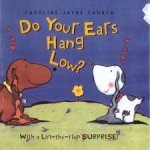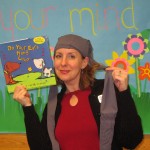 When I was little, I had a book with a 45 rpm record (yep, I’m that old) that I loved. It was “A Lot of Hot Water” read by Gordon from Sesame Street. Audio recordings of books have gone through a media transition or two, but it’s still a thrill to hear a good story read aloud by a talented reader. Jim Arnosky has a free downloadable MP3 version of his song “I’m a Turkey“, and my preschoolers this week gobbled it up. Arnosky’s folksy singing style is just right to get little listeners talkin’ turkey with him. The large art and short text in this book make it a fast, easy storytime choice. I’m going to share more books with cds or MP3 versions with my students. I’m sure they enjoy listening to another voice besides mine!
When I was little, I had a book with a 45 rpm record (yep, I’m that old) that I loved. It was “A Lot of Hot Water” read by Gordon from Sesame Street. Audio recordings of books have gone through a media transition or two, but it’s still a thrill to hear a good story read aloud by a talented reader. Jim Arnosky has a free downloadable MP3 version of his song “I’m a Turkey“, and my preschoolers this week gobbled it up. Arnosky’s folksy singing style is just right to get little listeners talkin’ turkey with him. The large art and short text in this book make it a fast, easy storytime choice. I’m going to share more books with cds or MP3 versions with my students. I’m sure they enjoy listening to another voice besides mine!
After sharing I’m a Turkey, we stretched by doing the Turkey Jerky. It’s like the Hokey Pokey, except you put your right wing in, your left wing, your tail feathers , etc. After announcing “that’s what it’s all about!”, we gobbled twice instead of clapping.
 Next, I gave each student a feather from the craft store. I showed them this turkey decoration (the kind that folds flat to store but unfurls into a kind of fan for show) and we said this rhyme:
Next, I gave each student a feather from the craft store. I showed them this turkey decoration (the kind that folds flat to store but unfurls into a kind of fan for show) and we said this rhyme:
There was a little turkey who had lost his tail.
When he saw it was gone, he began to wail.
“Oh woe is me! Please tell me whether
You have found my red tail feather!”
Whoever had a red feather could stick the feather in one of the holes on the turkey. We repeated the rhyme and changed it until all the colors of the feathers were used. It took me less prep time to use the turkey decoration and feathers we already had than to make the bulletin board out of construction paper like I’d originally planned, and the students loved sticking in the real feathers. Having two easy, inexpensive activities to go with a book sung by a fun artist made me very thankful indeed!
For more information, visit jimarnosky.com.


